|
Master the triangle of success
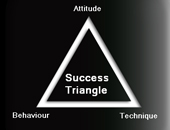
Knowledge, skills and attitude make up the three most important ingredients of career success. While knowledge and skills can be gained, can one be trained to have the right ‘attitude’?
read more... |
Wake-up call – Can you deduct wages if staff can't get into work?

Is it lawful to make a deduction from employees' wages when they can't get to work due to travel disruption? Gemma Brown explains
read more...
|
|
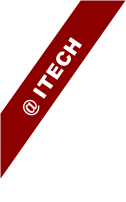 |
NEW PROJECT WIN !
Itech Solution has bagged the opportunity to develop a software for Transcription Management.
The client was already using a software which was developed using Visual Basics. It had many limitations like problems during uploading the audio files to the server, proxy issues, operating system compatibility and performance issues. Also, since the software was LAN-based, the admin had to manually check if any voice files are uploaded and lot of co-ordination was required.
Itech Solutions has come up with a solution for all these processes by proposing a Web Based software through which most of these tasks which are now done manually, can be completed by the software itself.
read more...
|

|
|
|
|
Product Development : 9 steps for creative problem solving

Creativity is the main prerequisite for innovation. However, our culture emphasizes critical thinking to the near exclusion of creative thinking (although it was the key to success in the Information Age).
read more...
|
Web 3.0: The Semantic Web and Intelligent Transportation Systems
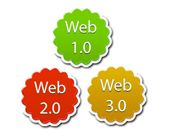
The semantic web, (or Web 3.0) will enable automated data and information exchange between machines (computers) and systems (software applications) through the use of use of ontologies, new data formatting and new meta data structures.
read more...
|
| |
|
Detailed Articles |
|
Master the triangle of success

Where do you think you will be career-wise after a decade, as compared to your classmates? Do you think only top-ranking students become successful in life? What do you feel might happen to that classmate of yours who is the butt of jokes and ridicule?
If you believe only academic brilliance leads to success, you must revalidate your opinion; or read books such as, ‘Think and Grow Rich’ by Napoleon Hill, which is the summation of hundreds of success stories.
The key questions in your mind should be: How do people become successful in their chosen professions? What’s the secret of their success?
Evaluation of success stories of statesmen, business-persons, actors, writers, educationists, is a revelation and one can come up with several concepts behind their success. A proven concept is the ‘Triangle of Success’, representing the three success ingredients: Knowledge, Skills and Attitude.
The magic triangle
Which success ingredient is more important? Even though difficult to generalise, in the work environment, the stress is more on ‘attitude’, with the belief that ‘knowledge’ and ‘skills’ required for the job can be imparted. However, in general, the Triangle of Success is equilateral, affirming that all three aspects are equally vital.
Knowledge:
In an academic environment, knowledge represents the core curriculum, irrespective of the courses. To illustrate, in a Management course, to make learning more comprehensive, the curriculum includes such diverse subjects as Economics, Finance, Human Resources, Organisational Behaviour, apart from Management. Knowledge can be said to be the foundation for success.
Skills:
Our educational system focuses on imparting knowledge for a career and not on essential soft skills. For example, any career requires skills such as planning, time management, logical reasoning, inter-personal relations, presentation skills etc. to apply knowledge in a practical situation.
Attitude:
While knowledge and skills are essential, they are not adequate for success. A study attributed to Harvard University found that people are employed, 85 per cent of the time because of their attitude, and only 15 per cent of the time because of how smart they are and how many facts and figures they know. Surprisingly, almost 100 per cent of educational money goes into teaching facts and figures which account for only 15 per cent of success at work!
Attitude includes key aspects like honesty, integrity, self-confidence, cooperative attitude, expectations, energy levels, optimism and so on, which are critical for career success
Interdependency of ingredients
The desire to be successful in a chosen profession is widespread. This desire, which is more an intention, should evolve into a plan of action. The interdependency of knowledge, skills and attitude, must be clear before translating your desire into an action plan.
Knowledge from an academic environment is the foundation for the chosen field. Degrees in Management or Engineering, may prepare you with fundamental knowledge for management and technical careers.
Communication, analytical and presentation skills make you competent and ahead of others in these professions. Depending on professional requirements, you must acquire complementary skills to be effective.
Remember the adage, ‘a Ferrari never wins any race while it is in the garage’. Similarly, the knowledge that you possess and the skills that you acquire, govern your potential. However, your productivity depends on how positive your attitude is. Lou Holtz, the famous football coach said this most appropriately, “Ability is what you’re capable of doing. Motivation determines what you do. Attitude determines how well you do it”.
Article Source
|
|
|
Wake-up call – Can you deduct wages if staff can't get into work?
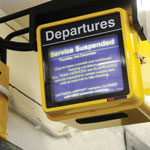
THE PROBLEM
I have an employee who was unable to attend work owing to travel disruption. Do I have to pay him for that shift? What should I do if this happens again and is there anything I can do to minimise anticipated travel disruption?
THE LAW
It is unlawful to make a deduction from a worker's wages unless the deduction is authorised by statute, by a contractual term that has been notified to the worker in writing, or by the worker having given their prior written consent.
The first thing to establish is whether there has been a "deduction" at all, and there will be no deduction unless the employee can establish some legal right to the wages in question.
The key issue is to decide whether there is a contractual right to be paid if the employee cannot attend work.
There is often no obvious express or incorporated term, and no evidence of custom and practice. The basic contractual position in such cases depends on the type of contract.
Hourly-paid employees with no guaranteed hours have no contractual right to wages unless the employee actually turns up and works in accordance with their contract.
Salaried employees are entitled to be paid even if not provided with work, so long as they are "ready and willing" to work. In these circumstances, the position is less clear. Case law supports the view that provided the non-performance of work is involuntary and unavoidable, the employee may be entitled to their wages. In view of the lack of any conclusive case law on this subject, the rights of employees who are unable to work due to travel disruption may depend to a large degree on how the parties have behaved on previous occasions. Where there is nothing from which a contrary intention can be inferred, it would appear that wages should continue to be paid during unavoidable absence.
EXPERT ADVICE
There are a number of business reasons to pay employees even if they are unable to come in to work, not least to enhance employee relations and boost morale by showing empathy to employees and providing a flexible and fair solution.
On the other hand, paying all staff regardless of whether they are able to work may encourage some employees not to make the effort. It is important in those situations to ensure that employees who turn up for work feel that their efforts have been recognised.
Where employees know that failure to attend work will result in loss of pay, employers may experience an increase in sickness absence. To reduce anticipated absences employers could inform employees in advance that all sickness absence during the relevant period will be followed up with a return to work meeting.
Employers should consider preventative measures to minimise disruption. This could include homeworking where appropriate or varying hours of work to avoid particularly congested periods.
The employer may want to offer employees the opportunity to take the absence as paid annual leave, assuming they have sufficient entitlement remaining, or could allow the employee to make up the lost hours on other days.
CHECKLIST
-
Develop a business continuity plan incorporating a strategy to deal with major travel disruption.
- Decide whether employees will be paid if they cannot make it to work, and ensure any guidance is applied consistently.
- Implement a policy setting out how you will deal with major travel disruptions.
- Publicise the policy internally before any likely period of travel disruption, and ensure that all staff and managers are aware of their responsibilities.
- Consider alternatives such as homeworking or varying hours of work.
- Consider the employee relations angle and effects on staff morale.
BEWARE
It is important that staff are treated fairly in these circumstances, not only to avoid feelings of resentment where some employees are paid and not others. Treating staff differently could result in claims of, for example, discrimination or less favourable treatment for taking time off to care for a dependant whose care arrangements are disrupted. Such claims can result in uncapped awards at the employment tribunal. Employers should also consider the effects of bad publicity associated with docking employees' wages.
Article Source
|
|
|
NEW PROJECT WIN !
Itech Solution has bagged the opportunity to develop a software for Transcription Management.

The client was already using a software which was developed using Visual Basics. It had many limitations like problems during uploading the audio files to the server, proxy issues, operating system compatibility and performance issues. Also, since the software was LAN-based, the admin had to manually check if any voice files are uploaded and lot of co-ordination was required.
Itech Solutions has come up with a solution for all these processes by proposing a Web Based software through which most of these tasks which are now done manually, can be completed by the software itself.
Access to the Transcription Management Software will be through a Login and Password on the Home page itself. Additional features like Role based access, Streaming audio and Online Java Web Editor would make File editing and formatting to be done within the software. It would calculate Line Count and other checks within the software. Since the Audio files and Transcribed documents are hosted within the Dedicated server, high security of these would be possible. Automatically sending the correct Transcribed document to the correct Doctor without manual intervention is possible. Alerts and Online chat would improve the communication between different users. The Application will include a ‘Help’ functionality for users. Centralized Database is used so that one version of the Data is maintained.
The Project is estimated to complete in about 6 months.
|
|
|
Product Development : 9 steps for creative problem solving
Creativity is the main prerequisite for innovation. However, our culture emphasizes critical thinking to the near exclusion of creative thinking (although it was the key to success in the Information Age). Today’s business is dominated by global complexity and commoditization. On the other hand, experts believe that creativity will be the driving force behind business success in the coming decades.
What constitutes creative thinking? For one, learning to think expansively and visually — to see patterns and “connect dots.” You also need to let your subconscious mind do a bulk of the work by temporarily disengaging your logical mind — in other words, Einstein’s process of mental incubation. And, once you have an idea, it’s important to be able to communicate it clearly and accurately to others.
In business, the process of generating and commercializing a good idea has been honed by creative industries for more than a hundred years. This infographic presents nine major steps toward creative problem solving for new product development.
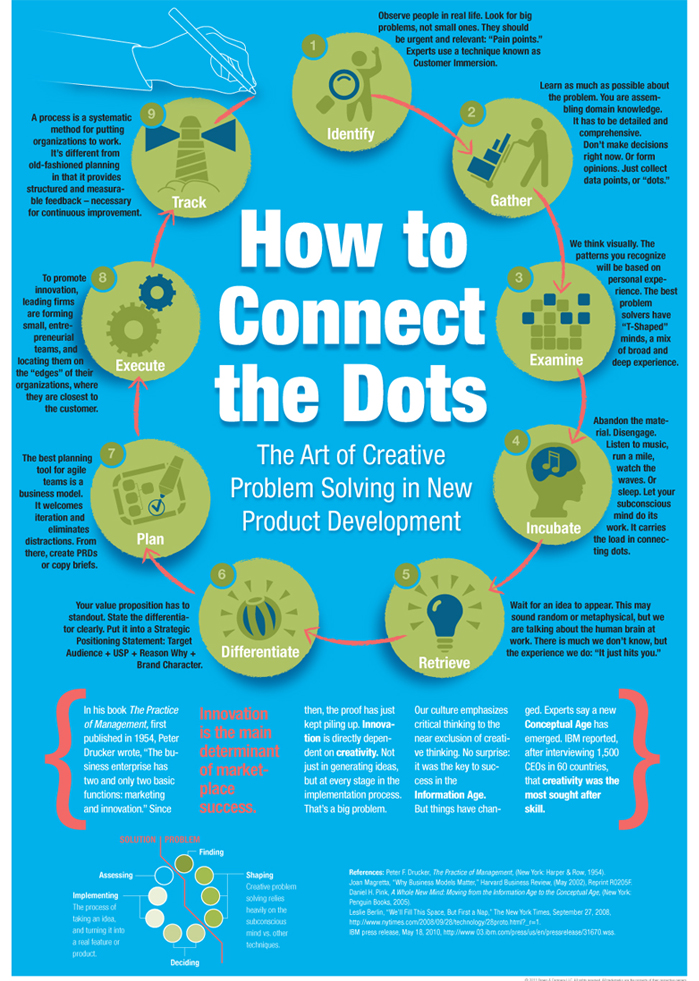
Article Source
|
|
|
Web 3.0: The Semantic Web and Intelligent Transportation Systems
Web 1.0 generally instituted a one-way communications framework through the use of static web sites and web services, essentially providing a read-only interface between the web and the end-user. Web 2.0 introduced collaborative, two-way communications technologies and a suite of innovative communications tools built on top of collaborative philosophies. The next generation of the internet is a subject of great debate, yet many agree that we will see a transformation from a “web of pages” to a web of data, primarily through the use of “semantic web” technologies.
The semantic web, (or Web 3.0) will enable automated data and information exchange between machines (computers) and systems (software applications) through the use of use of ontologies, new data formatting and new meta data structures. By applying “semantics”, or meaning to linked data sets with new descriptive meta data (or tagging), computers can begin to add meaning to data as it relates to real-world objects, subsequently automating human functions such as data search, data aggregation and data analytics, thus implementing automated two-way, peer-to-peer collaborative communications.
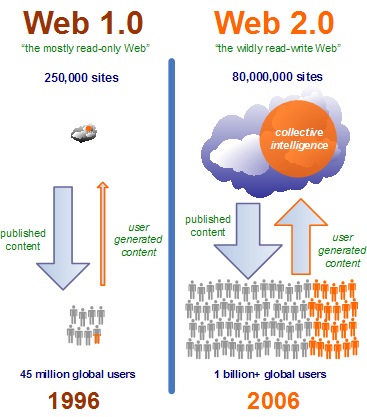
Web 3.0 technologies will enable ITS applications to automate data and information exchange and limit the need for human interaction. Context-aware and location-based services data linked to individual travelers will automatically interface with regional operating systems and regional traveler information systems, thus eliminating the need for human support on both the operator and end-users part. Real-time transportation data including vehicle, pedestrian and transit data will be automatically fused and processed with algorithms to establish new, next-gen regional operations platforms. Semantic technologies will also provide an essential component for support of the connected vehicle platform. Vehicle-to-vehicle (V2V) and Vehicle-to-Infrastructure (V2I) will utilize semantic technologies for automated, real-time data exchange. Mobility is becoming more and more reliant on the ability to apply effective social engineering and behavior management strategies, rather than the application of traditional physical technologies. Semantic technologies will provide a key tool for the integration of social (personal) data with centralized applications and overarching transportation systems.
Semantic web technologies are still very much in their infancies; however the transformation is well underway. Early signs show that the semantic web will take time to implement, most likely in stages as the web transitions vast existing data sets to include semantic data formats. The transportation industry, and more specifically the ITS industry is primed for becoming early adopters of web 3.0 technologies. Research and demonstration projects are already underway within the transportation industry. It’s just a question of when will the “tipping point” be realized.
Article Source
|
|
Itech Solutions |
|









